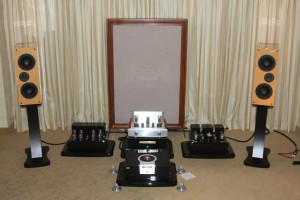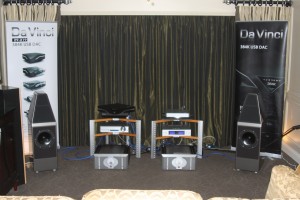In part one of this series, we focused strictly on room size and volume. It is the most single important variable when it comes to realizing the full potential of our music systems. Without the room to run free, low frequency energy builds up within our rooms and excites the air inside our room turning it into a resonate cavity. Resonances must then be managed through proper room absorption technology and dealing with resonances below 80 cycles takes special sound absorption technology. If we get the dimensions correct from the beginning, we will hear more music from our systems.
Speaker Set Up
Once we have determined the correct room size for our playback system by following the suggested height, width, and length ratios, we are ready to set our two channel system up. Finding the correct location for our speakers and listening position is our task and we must locate these three positions at proper distances to obtain the smoothest frequency response we can achieve within the room. There is a position that will give us the smoothest response where all frequencies are evenly represented and resonances are minimized.
How To Begin
To start, lets divide our rectangular room into thirds. A rectangular room configuration is essential because it offers us predictability. With a rectangular room’s parallel surfaces, we have energy that is moving and striking surfaces that are predictable distances from each other. Yes, parallel surfaces are not wanted when we are dealing with middle and high frequencies, but this can be better managed in a rectangular room. It is also easier to deal with low frequency issues within a rectangular room due to the room’s shape consistency.
Measure, Measure, Measure
After we have divided the rectangular room into thirds, we need to position our speakers along the first third division line we have set up within our room. Position the speakers at least 4′ from the side walls. Make sure both side wall/speaker distances are equal. Now, take a frequency response measurement at the listening position. There are numerous software programs that will assist you with this measurement. Look at the curve and notice any peaks or dips in it. Divide the response curve up into two sections. look at the response curve above 100 cycles and then look at it below 100 cycles. Move your speakers 6″ forward from your start position and take another measurement. Repeat the same procedure by moving the speakers 6″ back from the start position and measure again.
Look For Patterns
Now, lets examine the three response curves we have taken. We should begin to see some patterns developing. Lets look at the response curve below 100 Hz. What does the curve look like at the original start position. How about the one with speakers forward. Is it smoother or more exaggerated. Is the response curve below 100 Hz. better when the speakers are more forward into the room. It probably will be. Now, lets move the speakers another 6″ forward and take another measurement. Repeat this procedure focusing on all energy below 100 cycles. One will start to see a pattern developing and the smoothest curve will eventually show itself.
Listening Position Position
We want our new speaker locations to be in synch with the listening position. If our speakers end up being 8′ apart, then we should start with our listening position at 8′ so that the speakers and the listening position form the angles of an equilateral triangle. If more sound stage width is desired the listening position can be moved backwards. Move at small increments. Don’t forget about listening position height. One may find that elevating the listening position up a few inches may take the listening position out of the direct beaming of the tweeter and balance the tweeter and mid range out more evenly. Remember, it is the off axis energy that includes the room sound and moving listening position up may benefit.
Sub Woofer Position
Are we adding a sub woofer? If so, we need to treat that low frequency device as its own system and find the correct position for it. Do not and I repeat do not put it into a corner. The corner of our rooms is where all room modes end and accumulate. We do not want to place a low frequency energy device in the corner and excite all of these room modal issues. Lets leave sleeping modes lie. Place the sub woofer along the longest wall about 1/3 of the way down the wall. Measure the room response. Raise the sub woofer up 12″ in the same position and measure again. Change to the shortest wall width and repeat the procedure. You will quickly see that maybe two sub woofers and possibly three would be even better to equalize the pressure within the room.
Move And Measure
Speaker and listening position have to be located within the smoothest measured room frequency response curve location which is determined by moving speakers and then measuring. All of this moving and measuring must have an eye towards the best response curve. It will appear, just keep moving in small increments and then measuring. Once found, align the listening position from the speakers. Don’t forget to move up at the listening position a few inches to add more room sound. Off axis sound is different from on axis frequency response. Treat the sub woofer as its own speaker. Start 1/3 of the way down the long wall and measure. Raise the sub off the floor and measure. This up front time will be well spent, you will see in part three of this series on “How To Build A Dedicated Listening Room”.
How to build a listening room part one
How to build a listening room part three
How to build a listening room part four
If you would like a free analysis of your current room plans, please complete the form on this page www.acousticfields.com/free-acoustic-treatment-room-analysis-tell-us-about-your-room/ and we will run a free analysis for you. Alternatively, if you want to learn more about this subject please sign up for our free room acoustic treatment videos and ebook which provide step by step instructions. Get instant access by signing up now.
Thanks
Mike









The discussion on ductwork noise transmission from Acoustic Fields highlights crucial aspects of HVAC system acoustics. The movement of air…
Great build plans. thank you Denis
You must use absorption. Never place a chair against a wall.
A friend and I built several diffusors using these plans and they turned out absolutely beautiful. Very good instructions and…